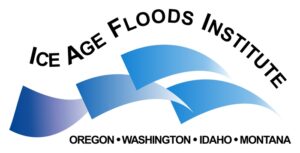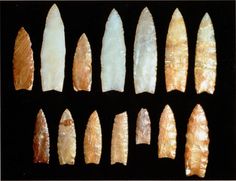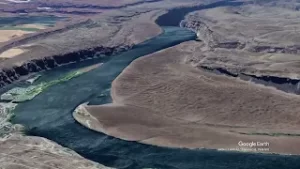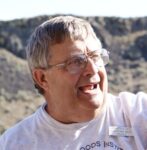
Introducing IAFI’s K-12 Education Grant Program
IAFI Grants Empowering Teachers to Share the Ice Age Floods Story with Students Mini-grants of up to $500 now available for






Apparently, some of the earliest and some of the latest of the Ice Age Floods roared along the Columbia River through the Wenatchee area. They left fields of giant megaripples on massive point bars along the river, and back-flooded the tributary rivers that fed into the Columbia.
At places like West Bar on the Columbia, it’s easy to recognize where the field of megaripples deposited by the massive early Floods have been cut into by later, smaller (though still huge) Floods during the waning period of the last ice-age.
In the times between, the Okanagan Lobe of the Cordilleran Ice Sheet blocked the path of the Columbia River and diverted the Floods down the Moses and Grand Coulees.The Wenatchee Valley Museum and Cultural Center offers a wealth of information about the Floods, indigenous peoples in the area, and much more.

President
Jeff Becklund
808-283-6831

Vice-President
Open

Treasurer
Jeff Beckland
808-283-6831

Publicity
Susan Freiberg
509-663-1337

Wenatchee Valley Erratics Chapter monitors current and trending information from USGS, Universities, Colleges and others. Our members include Geology Professionals and Others who host periodic Field Trips, Presentations and Other Events. For more information email us at Wenatchee@iafi.org.
The Erratics Chapter meets the second Tuesday of every other month (beginning with the second month of the year) at the Wenatchee Valley Museum and Cultural Center, 127 S. Mission St, Wenatchee, Wash. Meetings begin at 7 p.m. and are always free and open to the public.
Please see the Upcoming Events or the General Events Calendar for a listing of all chapter meetings and events.
Our associate, the Wenatchee Valley Museum and Cultural Center, provides a comfortable 50 passenger air conditioned coach for our tours at a small fee.
We cordially invite you to Join the IAFI Wenatchee Valley Erratics Chapter where you will learn new and amazing things about our surrounding area and have fun too! Members get reduced rates for all our functions – BECOME A MEMBER!







IAFI Grants Empowering Teachers to Share the Ice Age Floods Story with Students Mini-grants of up to $500 now available for

We’re reaching out to ask for your help. As we work toward our mission of promoting public awareness and education

This year’s IAFI June Jamboree delved into the fascinating geological history of Spokane Valley, contrasting it with the iconic Grand

“Scabland” – the Movie, A Google Earth Odyssey “Scabland” is a media complement to CWU Professor Nick Zentner’s 2023-2024 A-Z

Wenatchee, Washington is often called the “Apple Capital of the World” or the “Buckle of the Power Belt of the

Because of problems with the Zoom broadcast of the Erratics’ October 10th program, Ralph Dawes graciously recorded for us his
Upcoming IAFI Events


Chapter Location
Upcoming Chapter Events

In the fall of 2000, the Ice Age Floods Institute (IAFI) Board decided it was time for individual local chapters. The Wenatchee Valley Erratic’s became the first chapter in the spring of 2001. Charles Mason was elected president, Ken Lacy, Vice-President, and Susan Lacy Secretary/Treasurer, and Wilf Woods (Wenatchee World Newspaper Editor) took the Public Relations position. For many years, the Erratic’s were the largest of the chapters, sometimes having over 125 members from all over the country. Shortly after Charlie Mason took over as president the Wenatchee Valley Museum and Cultural Center (WVMCC) was established as the meeting place for the Erratic’s. This tradition that continues today.
By the Spring (2001) IAFI Board meeting in Moses Lake, Charlie had a chapter name (Wenatchee Valley Erratic’s), a non-profit designation, a staff geologist (Don Anspach, then a teacher studying geology), a meeting location, and of course, officers. The name Erratic’s was voted on (Marv McCamey suggested it) for the numerous ice-rafted erratic’s deposited by flood waters along in the valleys near Wenatchee and East Wenatchee, Washington.
After a couple of years Charlie Mason relinquished the chapter presidency to Susan first and then Ken Lacy as president of the Erratic’s in the mid-2000’s. Susan and Ken played a pivotal role in getting speakers, planning field trips and welcoming ice age flood dignitaries to their home in Trinidad, Washington, with has a beautiful view of West and Crescent Bars out their front window. Cliff Hassell served as president for two years.


In 2007 Brent Cunderla took over the president position from Susan Lacy and wa in that capacity until recently. Several years later Dan Smith became treasurer and has done an excellent job of keeping members enrolled in the chapter. Susan Freiberg (publicity coordinator) has been providing announcements of programs since the Wenatchee Valley Erratic’s became the first chapter of the Ice Age Floods Institute (IAFI) in 2001. She has done an excellent job of keeping track and compiling a list of all speakers/ programs that have occurred for the Erratic’s since the chapter was established. Dr. Ralph Dawes (Professor in Geology-Wenatchee Valley College), Susan Freiberg, Ken and Susan Lacy, and Brent Cunderla have all participated in obtaining speakers for the Wenatchee Valley Erratic’s programs.
During the mid-2000s Susan and Ken Lacy and Karen Atkerson were instrumental in developing field trip logistics for the chapter. Their work involved all aspects of the tours including registration, collecting fees, transportation, meals, trip leader, and scheduling. Susan was so good at organizing the field trips that she wrote up a detailed listing of steps to take to organize field trips. This document was utilized by other IAFI chapters in organizing their field trips. By about 2010 Karen Atkerson was no longer able to coordinate field trips so the Wenatchee Valley Museum & Cultural Center (WVMCC) became the new organizer for running field trips. This alleviated having a lot of volunteers from the WVE’s trying to organize field trips. Only the trip leader was provided by the Erratic’s, with the WVMCC taking care of the entire trip logistics (i.e. registration, collecting fees, transportation, etc.).
The Wenatchee Valley Erratic’s Chapter lies along the northern edge of the Channeled Scablands/Waterville Plateau. Some of the important Ice Age Flood related features in the chapter include Moses Coulee (second only to Grand Coulee), the northern flood route around the “Big Bend” of Columbia River Basalts into the Columbia River Valley north of Wenatchee, Washington, western half of Glacial Lake Columbia (held back by the ice dam of the Okanogan Valley) and the numerous well preserved (due to semi-arid climate) glacial features of the Waterville Plateau (eskers, kames, drumlins, large glacial erratic’s, end moraine, etc.).
Besides having lectures and programs every other month at the WVMCC numerous field trips were planned on a yearly basis to illustrate unique Ice Age Floods and the geology of north-central Washington. Typically two to four field trips were done each year, with Ice Age Flood adventures to Moses Coulee, Waterville Plateau, Grand Coulee, Columbia Basin, and geology of the Wenatchee, Washington area.
One of the most interesting programs developed by the Erratic’s was the Ice Age Adventures for schools usually on Thursday and Friday and open to the general public on Saturday’s. About 400 hundred kids and adults visited the exhibits yearly. Waterville Plateau glacial flood features, Columbia River Basalts, rock collections, were done but the main attraction was a special ice-age six-stage tour from ancient Lake Missoula on westward through five more stages of the great ice age floods (ice dam collapse-northern Idaho, Channeled Scablands, Wallowa Gap and associated temporary lakes, Columbia River Gorge, and flood deposits in the Pacific Ocean). Several field trips have also been conducted from a pontoon boat in the Columbia River.
By Brent Cunderla